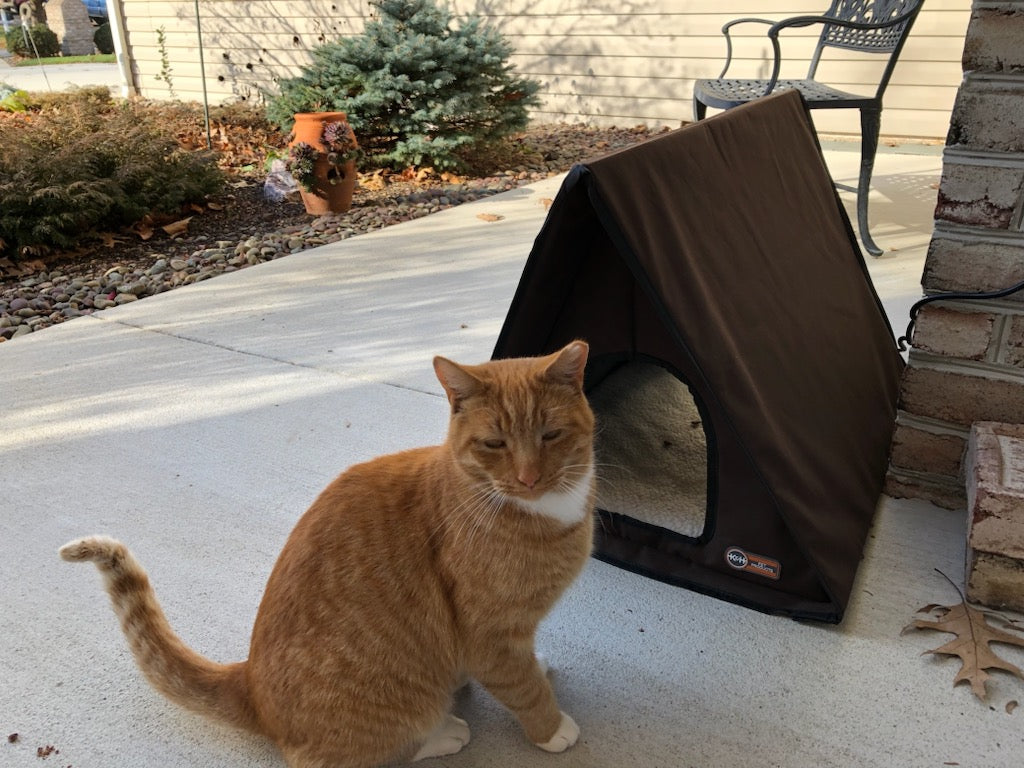
Can an outdoor cat become an indoor cat?
Every cat deserves a loving home, but sometimes outdoor cats have a tougher time finding a place where they fit in. You might, understandably, be worried about the cats you see outside when the weather heats up in the summer or dips below freezing in the winter. Can you help an outdoor cat become an indoor cat? In many cases, the answer is yes. But your approach and results may vary depending on whether the cat is feral or a stray.

What is the difference between a feral and a stray cat?
At first glance, it's not always easy to tell the difference between a feral cat and a stray cat. Feral cats have usually never been cared for by a human, so they don't want to be petted, and they'll often run from the humans who feed them.
Stray cats, in contrast, have been cared for by humans at some point in their lives. But if they've been on their own for a long time, they might initially act scared like feral cats. Unlike feral kitties, strays will eventually warm up to their caretakers. This means stray cats can become indoor pets, but feral cats typically can't. Sometimes it just takes time to figure out which category an outdoor cat falls within.
How to Bring a Stray Outdoor Cat Indoors
If a stray cat is wandering around outside your house, you can gently lead him down the path to becoming an indoor cat. Some outdoor cats will immediately warm up to the idea, and the process is as simple as opening your door. But others take time.
1. Lure an Outdoor Cat Inside with Food
First, try luring the cat indoors at mealtime, then let him come and go as he pleases. This helps him get used to the feel of your home. Gradually keep your door to the outside world closed for increasingly longer periods until you stop letting him leave at all.
2. Set Up a "Sanctuary" Room
If you're uncomfortable with the gradual approach that lets your cat come and go, try setting up a "sanctuary room" instead. Choose a small room in your house where your outdoor cat will live for a few days or a week when he first moves into your home. It gives him time to adjust to new sounds and smells slowly. Furnish it with a litter box, scratching posts, food, water, a snuggly bed (like the K&H Knitted Pet Bed) and a cat tree if there's space. This is also a good approach if you have other pets because it gives everyone time to get used to each other's smells without feeling threatened.
If your outdoor cat doesn't already know how to use a litter box, this is also a good way to help him slowly get used to using one. He's more likely to use a litter box when he's in a small room rather than having access to your entire home.
3. Get Scratching Posts and Soft Kitty Beds
Your stray cat is used to having his own territory outside, so help him feel confident by giving him things he can call his own in your house too. A good place to start is with scratching posts like the K&H Creative Kitty Tunnel Cat Scratcher Toy. Sprinkle them with the included catnip to make them extra enticing.
Provide him with soft, comfy beds. The K&H Thermo-Snuggle Cup Heated Cat Bed is especially tempting when it's cold outside.
You might also try leaving a cat bed or house outdoors before your kitty moves in, letting your cat get his smell all over it. Move the bed inside when you bring your kitty indoors. To your cat, this would be like moving his furniture into your home. The K&H Thermo Outdoor Kitty House is the perfect option for this method. It comes in heated and unheated varieties, and it's built to be used outside or inside.
4. Get Your Cat Spayed or Neutered
Don't forget to take your outdoor cat to the veterinarian and get him neutered (or spayed if she's a female) right away. Hormones can make it tougher for outdoor cats to adjust to indoor life. They feel driven to go outside to find mates, so they're more likely to have behavioral problems like spraying, yowling loudly at windows or doors, or trying to escape a lot.
5. Keep Your Cat's Environment Mentally Enriching
Outdoor cats are used to going wherever they want and constantly being on adventures. Make sure his indoor environment is also mentally enriching so he's content to stay inside. Provide your cat with places to climb and hide, depending on his mood.
Set up a bird feeder outside a big window so he can have his own "cat TV." Then put a bed near the window to let him watch in between catnaps. Try the K&H EZ Mount Window Bed or the K&H Deluxe Kitty Sill with Bolster.
You also want cat trees he can scratch and play on, along with other things he can climb, like the K&H Kitty Tower. Don't forget to try interactive toys too.
Finally, give him supervised visits outdoors from time to time — but make sure he can't escape. Set up an outdoor tent for him to play in, a catio or train him to walk on a harness.
How can you help feral cats?
Unlike strays, feral cats may never adjust to being indoors. You can try the tips in this article, but not all feral cats will respond, and that's nobody's fault. They simply were never socialized.
For them, focus on providing shelters that keep them safe from the elements. Give the kitty access to your garage, barn or covered porch. Set up an outdoor shelter under an overhang that's protected from the weather. The K&H Thermo Outdoor Kitty House Extra-Wide is a great choice for feral felines.
Make sure your feral cat has access to water and food dishes protected from the elements. The K&H Outdoor Kitty Dining Room is one option that provides a slanted roof structure and pairs perfectly with the food and water bowls in the K&H Thermo-Kitty Cafe.
It's Possible to Move an Outdoor Cat Indoors
While moving an outdoor cat indoors can take time, it's worth the effort in the end. Not only will your kitty have a safer life full of love, but you'll have a companion to spend time with every day. You'll both be pleased with the decision in the long run.




Leave a comment